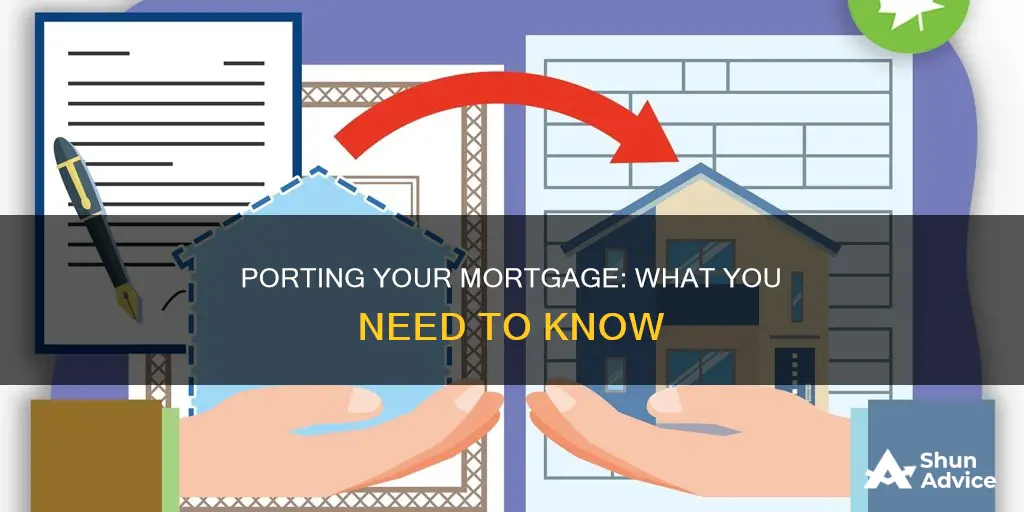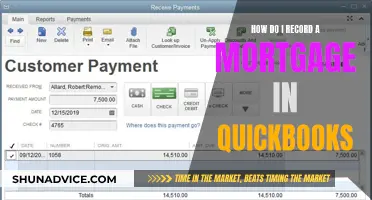
Porting a mortgage means transferring your existing mortgage to a different property when you sell one home and buy another. In other words, you can take your mortgage deal with you when you move to a new property. Porting can be a good option if you have a low-interest rate mortgage and current interest rates are higher, as you get to keep your existing rate. However, it may not always be possible to port your mortgage, and you may face other complications, such as prepayment penalties.
Porting a Mortgage:
| Characteristics | Values |
|---|---|
| Definition | Transferring an existing mortgage to a different property |
| Benefits | Avoiding exit fees, keeping a low-interest rate, saving money |
| Drawbacks | May not get the most competitive rate, potential early repayment charges, prepayment penalties |
| Requirements | Notify lender, provide proof of income, employment, financial documentation, new property details, etc. |
| Lender's Checks | Affordability, eligibility, property valuation |
| Time Limit | 30-120 days |
| Porting Process | Approval, signing documents, sale and purchase transactions, moving in |
| Top-Up Mortgage | Required for more expensive properties, blended interest rate |
| Repayment of Surplus | Partial repayment for less expensive properties |
| Additional Costs | Legal fees, appraisal fees, moving costs |
| Availability | More common outside the US, not all lenders or mortgages allow porting |
| Alternatives | Getting a new mortgage, letting the buyer assume the mortgage |
What You'll Learn
- Porting a mortgage is not always possible, and depends on the lender
- You may be able to port your mortgage if your new home is more expensive
- You may have to pay a penalty fee if you port to a cheaper home
- You may be able to borrow more and blend and extend your mortgage
- Porting a mortgage can save you money when financing a new house

Porting a mortgage is not always possible, and depends on the lender
Porting a mortgage is a convenient feature that allows you to transfer your existing mortgage to a new property. While many mortgages are portable, allowing you to retain the same interest rate, it is not a given that your lender will permit you to port your mortgage.
The availability of porting depends on your lender and the type of mortgage you have. Some lenders do not allow mortgage porting at all, and certain types of mortgages, such as variable-rate and restricted mortgages, cannot be ported. Even if your lender does permit porting, you may face obstacles. For instance, your lender may require you to reapply for the mortgage, and you may not qualify under their current eligibility criteria. Furthermore, if you are moving to a less expensive home, you may be subject to early repayment charges or prepayment penalties if your mortgage has a clause that restricts pre-paying more than 20% of the balance in a year.
If you are considering porting your mortgage, it is important to carefully review your mortgage contract and consult a mortgage broker or your lender to understand your options and the potential costs involved. Porting a mortgage can be complex, and it is crucial to weigh the benefits against the possibility of obtaining a more competitive rate with a new mortgage.
In summary, while porting a mortgage can be advantageous, particularly if you have a low-interest rate, it is not always possible, and the decision depends on various factors, including your lender, the type of mortgage, and your financial situation.
Moving Your Mortgage: A Guide to Smooth Transitioning
You may want to see also

You may be able to port your mortgage if your new home is more expensive
Porting a mortgage means transferring the terms of your mortgage to a new property. This means keeping the same interest rate, fixed-rate period, and fees. However, depending on the lender, you may be able to change the terms of your mortgage, for example, extending it from 25 years to 30 years.
If you are moving to a more expensive home, it may be possible to port your mortgage and borrow more, up to the maximum mortgage amount allowed. If you can borrow additional funds, you may find that this "top-up" is arranged as a separate mortgage deal, alongside the mortgage you port. This could mean it has a different and potentially higher interest rate, and may involve having to pay an arrangement fee for the deal. You will also effectively have two mortgages to manage, most likely ending at different times.
When porting a mortgage, the lender will carry out affordability checks to ensure that you can still afford the loan. If you had a perfect credit record when you took out the initial loan but your score has taken a hit since then, the lender will be more wary about approving your application. If you already had a less-than-perfect credit score when you took out the mortgage, still having an imperfect score may not prove a barrier to porting your home loan. Talk to your lender if you're concerned about your credit score.
There may be some fees and charges to pay when porting a mortgage, such as valuation fees and legal fees related to the property you're buying.
Making Woolwich Mortgage Overpayments: A Step-by-Step Guide
You may want to see also

You may have to pay a penalty fee if you port to a cheaper home
Porting a mortgage means transferring your existing mortgage to a different property when you sell one home and buy another. Many mortgages are 'portable', meaning you may be able to transfer your current mortgage product to a new property. However, even if your mortgage is portable in theory, you may still be blocked by your lender.
If you move to a cheaper property, you may not need to borrow as much money on your mortgage. In this case, you might face paying an early repayment charge on the amount of borrowing you don't port to your new home. For example, if you've got a £200,000 mortgage on a £250,000 property and move to a £200,000 home, meaning you only need a £150,000 mortgage, you might have to pay an ERC on the £50,000 you're not taking with you – something that could set you back £100s or even £1,000s.
In this case, it may make more financial sense to get a new mortgage from a different lender. Your existing lender might not let you port anyway if you don't need to borrow as much money. You can also avoid this fee if you make a small enough down payment. Putting less money down can decrease the difference between your existing mortgage amount and the new mortgage amount, lowering or eliminating your fee.
You may also need to pay fees for an appraisal, legal work or other services. There may also be an exit fee, which is usually a few hundred pounds. It might be called a deeds release fee or a final fee, but you may already have paid it upfront when you took out the mortgage, so check. Once you've exited your old deal, you'll likely need to pay an arrangement fee and valuation fee for your new mortgage.
Generate Mortgage Leads: Strategies for Success
You may want to see also

You may be able to borrow more and blend and extend your mortgage
Porting your mortgage means transferring your existing mortgage to a different property when you sell one home and buy another. Many mortgages are portable, but not all. For example, most variable-rate mortgages can't be ported. If you're getting a new mortgage, it's a good idea to ensure that you have the option to port it.
If you end up buying a home that requires a bigger mortgage than what you currently have, your lender may allow you to blend and extend a ported mortgage. Blended mortgages, including blend-and-extend mortgages, allow you to combine your current interest rate with a new, lower one. This can save you money without breaking your current mortgage.
With a blend-and-extend mortgage, you can renew your mortgage for a new term when blending. You can borrow a lump sum of cash worth up to 80% of your home's value. You will have to pay interest on the entire equity accessed from the beginning, even if you don't need it all at once. You can also access your home equity to borrow more money with a blended mortgage.
However, not all mortgage lenders offer blended mortgages. Some lenders will only offer blended mortgages if you're porting your mortgage to another property, or if you pay a mortgage penalty. Some lenders may also have certain requirements for you to blend and extend mortgages. For example, Coast Capital only allows you to blend and extend if you are borrowing at least an additional $50,000 to your mortgage amount or if the new term is longer than at least three years after your existing mortgage term expires.
Obtaining Mortgage Lien Documents: A Step-by-Step Guide
You may want to see also

Porting a mortgage can save you money when financing a new house
Porting a mortgage involves transferring your existing mortgage to a new property. This means that your mortgage rates, term, amortization, conditions, and remaining balance will remain the same. Porting a mortgage can save you money when financing a new house in several ways.
Firstly, by porting your mortgage, you can avoid exit fees associated with leaving a mortgage deal early. These fees can often cost thousands of dollars in early repayment charges. Porting allows you to keep the same mortgage terms, eliminating these costly penalties.
Additionally, if you have secured a low-interest rate on your current mortgage, porting enables you to retain that favourable rate when you move to a new property. This can be particularly advantageous if market interest rates have risen since you initially obtained your mortgage. By keeping your low-interest rate, you can benefit from lower monthly payments compared to the higher rates offered by new mortgages.
Porting your mortgage can also help you avoid the potential complexities and costs of obtaining a new mortgage. When taking out a new mortgage, you typically incur arrangement fees, valuation fees, and other charges. By porting your mortgage, you can bypass these additional expenses, as you are not breaking your existing mortgage contract.
Furthermore, if you are moving to a more expensive home and require additional financing, porting your mortgage may provide you with the option to blend and extend your mortgage. This means that your lender combines your existing mortgage with a new, larger mortgage, resulting in a blended interest rate that is often more favourable than starting a new mortgage from scratch.
However, it is important to note that porting a mortgage may not always be the most financially advantageous option. In some cases, you may face challenges with your lender, who will assess your financial situation to ensure you still qualify for the mortgage. Additionally, there may be instances where you have to pay prepayment penalties, especially if you are moving to a less expensive home and use the proceeds from the sale to significantly pay down your mortgage. Therefore, it is essential to carefully consider your circumstances, consult with a mortgage broker, and make informed decisions regarding porting your mortgage to maximize your financial savings.
Making Mortgage Payments: Wells Fargo Guide
You may want to see also
Frequently asked questions
Porting a mortgage means transferring your existing mortgage to a different property when you sell one home and buy another.
Porting a mortgage can be beneficial if you have a low-interest rate on your existing mortgage and current interest rates are higher. It also allows you to avoid exit fees and early repayment charges associated with breaking your mortgage contract early.
To port your mortgage, you need to notify your lender and submit the required documentation, including details of the new property and proof of income and employment. The lender will then assess your application and carry out checks to ensure you still meet their eligibility criteria and can afford the mortgage. If approved, you will need to sign the necessary documents and complete the sale and purchase transactions.







